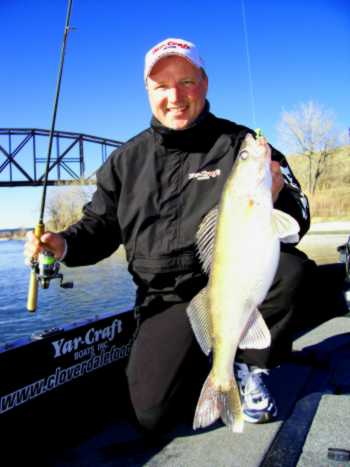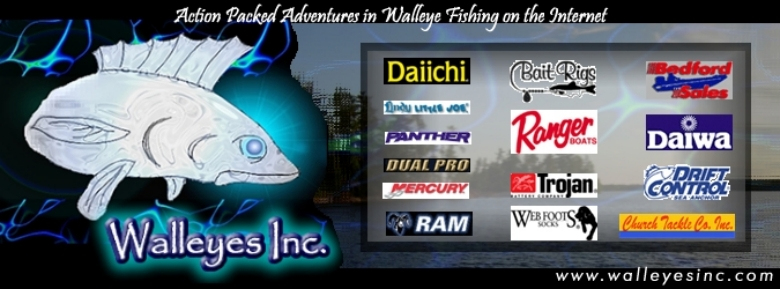Easily keeping the boat on a small spot for most of the
day can help anglers catch just about any kind of fish from
bass and sunfish to musky and walleye. Where the emphasis
on boat control however has really evolved has been in walleye
fishing applications. From reservoirs and natural lakes to
rivers and flowages, walleyes often seem edge or structure
orientated. Where fish may be scattered across flats or open
water, fish relating to structure or edges are concentrated.
If you want to catch walleye that are concentrated into a
tight spot, you need to keep the boat on the spot. Fortunately
for walleye anglers, there are a lot of tools at are disposal.
Ironically however, many anglers understand some of the obvious
tools but look past many simple pieces of equipment that can
make this undertaking much easier.
GPS
Global Positioning Systems have revolutionized walleye fishing
because anglers can log or save the exact locations of structure
or other fish holding locations. Not only are these tools
great for simply finding these locations again, quickly but
the GPS systems of today allow anglers to stay on the spot
or mark new spots as fish are discovered. Often, we might
mark the “structure” or spot we are fishing with
a waypoint and mark where we actually catch fish with icons.
This gives us a map of where we are catching fish. Combine
GPS with some of the new lake chips like those of Lake Master
and GPS becomes a crucial piece of equipment. The plotting
capabilities of the new GPS systems have evolved as well.
The new units are much more accurate and plot at much slower
speeds than just a few years ago.
 |
Marker Buoys
With the advent of GPS, many anglers quit using marker
buoys to physically mark structure or mark where they
caught fish. One obvious reason is that markers had
a tendency to attract other anglers. While these markers
can be obvious for other anglers to see, don’t
overlook the advantages. For tiny spots where boat control
is crucial, nothing works better than a marker buoy.
Another situation where markers shine is when you can
mark the spot and back off the spot, fishing the area
by pitching or casting. Shallow reefs or rock piles
are great candidates for this application. For myself,
I can stay on the spot better if I have something physical
in front of me to look at. Imagine a break line or rock
ledge that is only fifty feet long by five feet wide
or some other micro spot on the spot situation, throw
out a marker.
|
Drift Socks and Trolling Motors.
Trolling motors just keep getting bigger and stronger. Whether
you use a 36 volt system on a twenty foot fiberglass boat
or a 12 volt system on a fourteen foot aluminum boat, trolling
motors just keep improving. With that being said, many anglers
understand the obvious importance that a trolling motor can
be when trying to control a boat. Over the past decade, the
trend has been towards bow mount trolling motors where anglers
are controlling the boat from the casting deck on the bow.
We have also witnessed two other trends however that have
emerged. The first trend is the return of transom mounted
trolling motors on larger console boats. Back trolling might
seem like an outdated form of boat control that seemed to
disappear with the rise of big windshield boats but back trolling
is still so effective for controlling the boat that many anglers
are rediscovering. The other trend is the incorporation of
drift socks in conjunction with trolling motors. Drift socks
are another old tool that anglers are rediscovering. Drift
socks slow down the drift of your boat and also allow the
angler to control the boat in a predictable fashion.
Longer Rods
Roomier rod lockers might be the single biggest reason for
going to a relatively longer rod. Regardless, even anglers
in smaller boats without rod storage are discovering the advantages
of seven to eight foot spinning rods for jigging and rigging
applications. Why the longer rods and what does a longer rod
have to do with boat control? First off, longer rods allow
the angler to easier cushion the effects of large waves or
strong wind on the boat. Often, the abruptness caused by wave
action can have a negative effect on the presentation and
longer rods allow you to compensate or dampen this abruptness.
Regarding boat control, longer rods also allow you to fine
tune boat control even further because the length of the rod
allows anglers to point or hold the rod over the sweet spot
for longer periods of time.
Imagine if you will, a small spot the size of two pool tables
where the walleye are stacked. You have a marker buoy just
off the spot that is used to give you a visual mark to line
up off of. The tools on your boat enable you to stay in the
spot but the longer rod also allows you to compensate and
keep your presentation vertical in the spot for even longer
periods. The right rod can enable you to fine tune boat control
even further. In the end, the goal isn’t boat control,
but bait control. Remember that keeping the boat on the spot
is a part of the equation; the most important aspect is keeping
the bait in front of fish. If you are looking for a phenomenal
rigging rod that fits this bill, hold the Jason Mitchell Elite
Series JMS76MLX in your hand. You will be sold on these rods
once you use them as they are lighter and more sensitive than
any rod I have ever fished with. This rod company is located
in Devils Lake, North Dakota.
The Mental Aspect
All of these tools however fall short if we don’t understand
what we are fishing. In the simplest form, we are merely attempting
to put something a fish will eat in front of fish. Often,
this means live bait that looks good and keeping this bait
in front of many fish as possible for as long as possible.
Don’t make boat control any more complicated than it
already can be. Use the wind, use the current to aid you,
don’t fight the elements and keep the thought process
simple. Fish are often relatively easy to catch once you find
them.
Editors Note: Sheldon Meidinger is a past PWT Championship
qualifier with several top ten PWT finishes to his credit.
|

